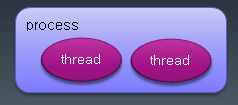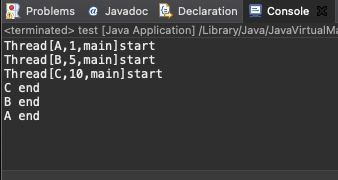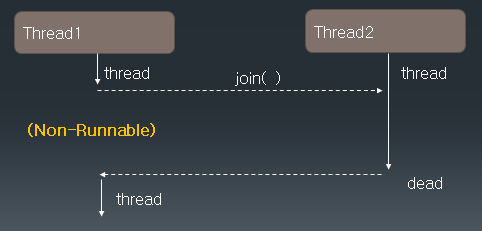Section 1. Thread
1. 스레드 (Thread)

프로세스를 구성하며 실제 작업이 수행되는 최소 실행 단위
2. 멀티 스레딩 (Multi-Threading)

- 여러 thread 가 동시에 수행되는 프로그래밍
- thread 고유의 작업 공간과 thread 사이에 공유하는 공유 자원 존재
- 동일한 자원을 서로 차지하려는 Race Condition 발생
- 멀티 스레딩 환경에서 자원의 경쟁이 발생하는 공유 자원 부분을 Critical Section 이라고함
3. Java Thread 생성하는 방법
- Thread 클래스 상속
- Runnable 인터페이스 구현
- 자바에서는 단일 상속만 가능하므로 Thread 를 구현하려는 클래스가 Thread 가 아닌 다른 클래스를 이미 상속 받은 경우에 Runnable 인터페이스 구현
4. Thread 클래스 상속
- main, th1, th2 총 3개의 스레드가 수행됨
- main 스레드는 th1, th2 를 실행시키고 종료됨
class MyThread extends Thread{
public void run() {
int i;
for(i = 0; i<200; i++) {
System.out.print(i + "\t");
}
}
}
public class ThreadTest {
public static void main(String[] args) {
System.out.println(Thread.currentThread()); # 현재 블럭에서 수행되는 스레드의 정보 출력
MyThread th1 = new MyThread();
th1.start();
MyThread th2 = new MyThread();
th2.start();
}
}
5. Runnable 인터페이스 구현
- Runnable 인터페이스를 구현 (run 메서드 오버라이딩)
- Thread 생성자에 Runnable 구현 객체 넘김
class MyThread2 implements Runnable{
public void run(){
int i;
for(i=0; i<200; i++){
System.out.print(i + "\t");
}
}
}
public class ThreadTest2 {
public static void main(String[] args) {
System.out.println("main start");
MyThread2 mth = new MyThread2();
Thread th1 = new Thread(mth);
th1.start();
Thread th2 = new Thread(new MyThread2());
th2.start();
Thread th3 = new Runnable() { # 익명 클래스로 구현
public void run(){
int i;
for(i=0; i<200; i++){
System.out.print(i + "\t");
}
}
};
th3.start();
System.out.println("main end");
}
}
Section 2. Thread 우선순위
1. Thread 우선순위
- 스레드가 CPU 를 할당 받는 우선순위
- Thread.MIN_PRIORITY(=1) ~ Thread.MAX_PRIORITY(=10)
2. Thread 우선순위 적용
- setPriority() / getPriority() 메서드 사용
class PriorityThread extends Thread{
public PriorityThread(String name) { # 생성자에서 스레드 이름 지정
super(name);
}
public void run(){
int sum = 0;
Thread t = Thread.currentThread();
System.out.println( t + "start");
for(int i =0; i<=1000000; i++){
sum += i;
}
System.out.println( getName() + " end");
}
}
public class test {
public static void main(String[] args) {
PriorityThread pt1 = new PriorityThread("A");
PriorityThread pt2 = new PriorityThread("B");
PriorityThread pt3 = new PriorityThread("C");
pt1.setPriority(1);
pt2.setPriority(5);
pt3.setPriority(10);
pt1.start();
pt2.start();
pt3.start();
}
}
- 결과
- A -> B -> C 순으로 실행됐지만 우선순위가 높은 C -> B -> A 순으로 종료가 됨

Section 3. join 메서드
1. 스레드 join 메서드

- 동시에 두 개 이상의 Thread가 실행 될 때 다른 Thread 의 결과를 참조 하여 실행해야 하는 경우 사용
- join() 함수를 호출한 Thread가 not-runnable 상태가 감
- 다른 Thread의 수행이 끝나면 runnable 상태로 돌아옴
2. join 메서드 사용
- main 스레드와 1부터 50, 51부터 100 까지의 합을 구하는 두 개의 Thread 총 3개의 스레드 존재
- join 메서드를 호출하지 않으면 main 스레드가 lastTotal 값을 구할 때 나머지 두개의 스레드의 수행 결과가 아직 나오지 않아서 0이 출력됨
- lastTotal 값을 구하기 전에 main 스레드가 join 메서드를 호출하여 계산 결과가 적용되면 다시 수행
public class JoinTest extends Thread{
int start;
int end;
int total;
public JoinTest(int start, int end){
this.start = start;
this.end = end;
}
public void run(){
int i;
for(i = start; i <= end; i++){
total += i;
}
}
public static void main(String[] args) {
JoinTest jt1 = new JoinTest(1, 50);
JoinTest jt2 = new JoinTest(51, 100);
jt1.start();
jt2.start();
try{
jt1.join(); # jt1 스레드가 종료되어야 main 스레드 수행 재개
jt2.join(); # jt2 스레드가 종료되어야 main 스레드 수행 재개
}catch (InterruptedException e) { # jt1 또는 jt2 스레드가 종료되지 않을 경우 예외
System.out.println(e);
}
int lastTotal = jt1.total + jt2.total;
System.out.println("jt1.total = " + jt1.total);
System.out.println("jt2.total = " + jt2.total);
System.out.println("lastTotal = " + lastTotal);
}
}
Section 4. Thread 인터럽트와 종료
1. Thread 인터럽트 (Interrupt)
- 다른 Thread 에 예외를 발생시키는 인터럽트를 보냄
- not-runnable 상태일 때 interrupt() 메서드를 통해 인터럽트를 걸면 다시 runnable 상태가 됨
2. Thread 종료
- 실제로 스레드가 쓰이는 경우는 거의 무한 루프로 계속 동작함
- private 멤버변수로 flag 를 생성하고 while(flag)의 flag 변수값을 false로 바꾸어 종료를 시킴